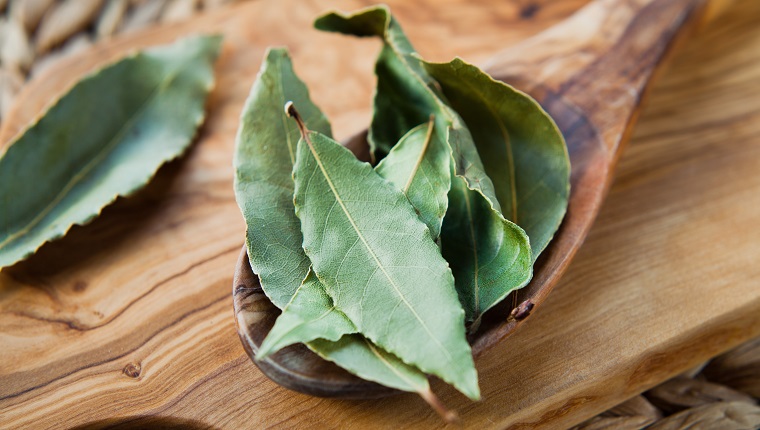No, bay leaves are not safe for dogs. They can cause stomach issues.
Bay leaves are a common ingredient in many recipes, known for their distinctive flavor. While they enhance the taste of human food, they pose risks for dogs. Consuming bay leaves can lead to vomiting, diarrhea, and other digestive problems in dogs.
The leaves contain compounds that are difficult for dogs to digest, making them harmful. It’s important to be aware of the potential dangers and keep bay leaves out of reach of your pets. Understanding which foods are safe for dogs is crucial for their health and wellbeing. In this blog post, we will explore why bay leaves are bad for dogs and how to keep your furry friend safe from such hazards.

Credit: www.dogster.com
Introduction To Bay Leaves
Bay leaves can be harmful to dogs if ingested. They contain compounds that may cause vomiting and diarrhea. Always keep bay leaves out of your dog’s reach.
Bay leaves are a common ingredient in many kitchens. They add flavor to various dishes. But are they safe for dogs? This blog will explore the safety of bay leaves for dogs.What Are Bay Leaves?
Bay leaves come from the bay laurel tree. They are dark green and oval-shaped. These leaves are often dried and used in cooking. They have a strong, aromatic scent. The flavor is slightly bitter but enhances many recipes.Common Uses In Cooking
Bay leaves are popular in soups and stews. They are added to marinades and sauces. People use them to flavor meats and vegetables. Some use bay leaves in pickling. They are also part of bouquet garni, a bundle of herbs. Bay leaves are removed before serving the dish. “`Bay Leaves And Dogs
Bay leaves are a common ingredient in many kitchens. They add a unique flavor to dishes. But what about our furry friends? Are bay leaves safe for dogs? This question worries many dog owners.
Potential Risks
Bay leaves can be harmful to dogs. They contain compounds that are not safe for pets. If a dog eats bay leaves, it may face several health issues. The leaves can cause digestive problems. They are also hard for dogs to chew and swallow. This can lead to blockages in their intestines.
Symptoms Of Ingestion
If a dog eats bay leaves, watch for symptoms. Common signs include vomiting and diarrhea. The dog may also have a lack of appetite. In severe cases, the dog might suffer from seizures. Another symptom is drooling more than usual. If these symptoms appear, take your dog to the vet immediately.
Toxicity Of Bay Leaves
Bay leaves can harm dogs if ingested. They contain eugenol and other toxic compounds. Always keep bay leaves away from pets.
### Toxicity of Bay Leaves Bay leaves are a common ingredient in many recipes, adding a distinct flavor to soups, stews, and casseroles. But when it comes to our furry friends, these aromatic leaves can spell trouble. Are bay leaves bad for dogs? Let’s dive into the Toxicity of Bay Leaves to understand more. ### Chemical Compounds Bay leaves contain eugenol, a chemical compound that is toxic to dogs. Eugenol can cause serious health issues even in small amounts. Another compound found in bay leaves is essential oils. These oils can irritate a dog’s digestive system, leading to discomfort. Bay leaves also have tannins. Tannins can lead to vomiting and diarrhea. Imagine your dog rummaging through the kitchen and munching on a bay leaf. The consequences could be dire. ### Effects on Dogs Dogs are curious creatures. They often sniff and taste things they shouldn’t. If your dog eats bay leaves, you might notice symptoms like vomiting, diarrhea, and drooling. In severe cases, bay leaf consumption can lead to more serious issues. These include difficulty breathing and even seizures. It’s not worth the risk. A small amount of bay leaf can cause a lot of harm. Why take chances with your dog’s health? Have you ever caught your dog nibbling on something it shouldn’t? How did you handle it? Keep bay leaves and other toxic foods out of reach. Your dog’s health and safety are paramount. Always consult your vet if you suspect your dog has ingested something harmful. Do you have bay leaves in your spice cabinet? Make sure they are stored securely. Your furry friend depends on you for safety.Safe Alternatives
Bay leaves can be harmful to dogs if ingested. They may cause digestive issues and blockages. Consider safer alternatives like parsley or cilantro for seasoning your dog’s food.
When it comes to ensuring your dog’s diet is safe and healthy, knowing which herbs and seasonings are safe is essential. Bay leaves might be harmful to your furry friend, but there are plenty of safe alternatives that can add flavor and nutrition to their meals. Let’s explore some pet-friendly herbs and safe seasonings that you can use instead.Pet-friendly Herbs
Adding herbs to your dog’s food can enhance flavor and provide health benefits. Parsley is a great choice. It freshens breath and is rich in vitamins. Just chop it up and sprinkle a small amount over their meal. Basil is another safe herb. It’s known for its anti-inflammatory properties and can help with arthritis. Plus, most dogs love the taste. Rosemary is not only safe but also beneficial. It contains antioxidants which can boost your dog’s immune system. A small pinch goes a long way.Safe Seasonings
When seasoning your dog’s food, simplicity is key. Turmeric is a safe option. It’s known for its anti-inflammatory and antioxidant properties. Just a tiny sprinkle can add both flavor and health benefits. Ginger is another safe seasoning. It aids in digestion and can soothe an upset stomach. Grate a small amount and mix it into their food. Cinnamon can be a delightful addition. It helps regulate blood sugar levels and has anti-inflammatory properties. Make sure to use it sparingly. Choosing the right herbs and seasonings can make your dog’s meals both tasty and safe. Have you ever tried adding any of these to your dog’s food? If not, give it a try and see how they respond. Your dog might just find a new favorite flavor!Preventing Accidental Ingestion
Preventing accidental ingestion of bay leaves is crucial for dog owners. Bay leaves can harm dogs, causing digestive issues and other health problems. By taking a few preventive measures, you can keep your furry friend safe and healthy.
Storage Tips
Store bay leaves in a secure, high place. Use airtight containers to keep the scent contained. This prevents your dog from sniffing them out. Avoid leaving bay leaves on counters or open shelves. Dogs can reach these areas easily. Regularly check for any fallen leaves on the floor. Clean them up immediately to avoid accidental ingestion.
Supervising Your Pet
Always supervise your pet while cooking. Dogs are curious and might try to grab food. Keep an eye on them during meal prep. If you drop a bay leaf, pick it up right away. Teach your dog commands like “leave it” and “drop it.” These commands can prevent them from eating harmful items. Supervision is key to keeping your dog safe.
First Aid For Ingestion
Bay leaves can be toxic to dogs if ingested. If your dog eats bay leaves, quick action is necessary. This section will guide you through the first aid steps to take.
Immediate Steps
First, stay calm. Remove any remaining bay leaves from your dog’s reach. Check your dog’s mouth and remove any leaves you find. Don’t induce vomiting unless advised by a vet. Give your dog water. This helps flush out the toxins. Monitor your dog closely for signs of distress.
When To See A Vet
Watch for symptoms like vomiting, diarrhea, or lethargy. These indicate that your dog needs medical attention. If your dog shows these symptoms, contact your vet immediately. Bring a sample of the bay leaves with you. This will help the vet in diagnosing the issue. Early treatment can prevent severe health problems.
Veterinary Treatments
Ensuring your dog’s health is crucial. If your dog eats bay leaves, veterinary treatments become necessary. This section covers diagnostic procedures and treatment options.
Diagnostic Procedures
First, a vet will conduct a physical examination. They check for signs of poisoning. Symptoms include vomiting, diarrhea, and lethargy. The vet may ask about your dog’s recent diet. Knowing the amount of bay leaves ingested is helpful.
Blood tests might be performed. These tests help assess the dog’s internal health. X-rays or ultrasounds are sometimes required. This helps identify any blockages in the digestive system.
Treatment Options
Treatment depends on the severity of symptoms. Mild cases often involve induced vomiting. This helps remove the bay leaves from the stomach. Activated charcoal is sometimes administered. It absorbs toxins in the digestive tract.
In severe cases, hospitalization may be required. Intravenous fluids help maintain hydration. Medications can reduce symptoms like vomiting and diarrhea. Surgery is rare but possible. It’s needed if there are blockages that can’t be resolved otherwise.
Regular monitoring is important after initial treatment. Follow-up visits ensure your dog recovers fully. Always consult your vet for the best care plan.

Credit: dogtime.com
Long-term Care
Bay leaves can be harmful to dogs if ingested. They may cause digestive issues and other health problems. Always keep bay leaves out of your dog’s reach.
Bay leaves can be harmful to dogs. If your dog has ingested bay leaves, long-term care is necessary. It helps ensure their health and well-being. Below are some steps for long-term care.Monitoring Your Dog
Watch your dog closely. Check for signs of illness. Symptoms include vomiting, diarrhea, and lethargy. If you see any symptoms, contact your vet. Keeping a journal of your dog’s health can be helpful. Track changes in behavior or appetite.Preventive Measures
Keep bay leaves out of reach. Store them in sealed containers. Ensure your dog does not have access to the kitchen. Educate family members about the risks. Use pet-safe plants in your home. Be cautious with herbs and spices. Regular vet check-ups are important. They help catch any issues early. “`
Credit: thundermountainline.com
Frequently Asked Questions
Are Dried Bay Leaves Safe For Dogs?
Dried bay leaves are not safe for dogs. They contain compounds that can cause digestive issues and toxicity. Always keep bay leaves away from pets.
Is Burning Bay Leaves Toxic To Dogs To Humans?
Burning bay leaves can be toxic to dogs and humans. The smoke may cause respiratory issues and allergic reactions. Keep pets and people away from burning bay leaves.
What Happens If A Dog Eats Bay Leaf?
A dog eating a bay leaf can experience vomiting, diarrhea, and gastrointestinal discomfort. Consult a vet immediately if symptoms persist.
Can Dogs Eat Rice Cooked With Bay Leaves?
Dogs can eat rice, but avoid bay leaves. Bay leaves can be toxic to dogs. Stick to plain rice.
Conclusion
Bay leaves can harm dogs. They may cause vomiting and diarrhea. Always keep bay leaves away from pets. Consult your vet if your dog eats them. Pet safety is crucial. Choose dog-safe herbs for cooking. Keep your furry friend healthy and happy.
Make informed choices for their well-being. Thanks for reading!